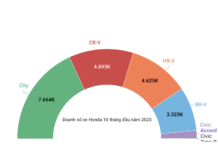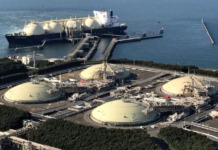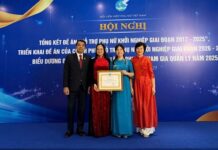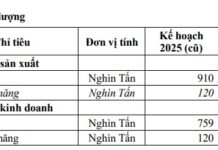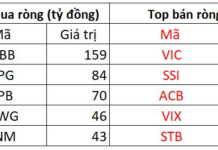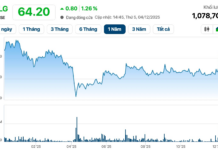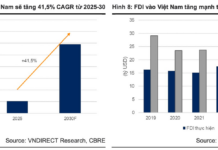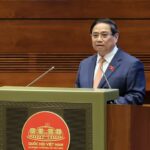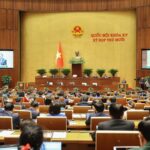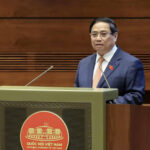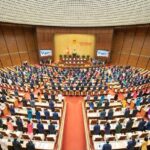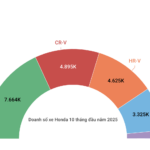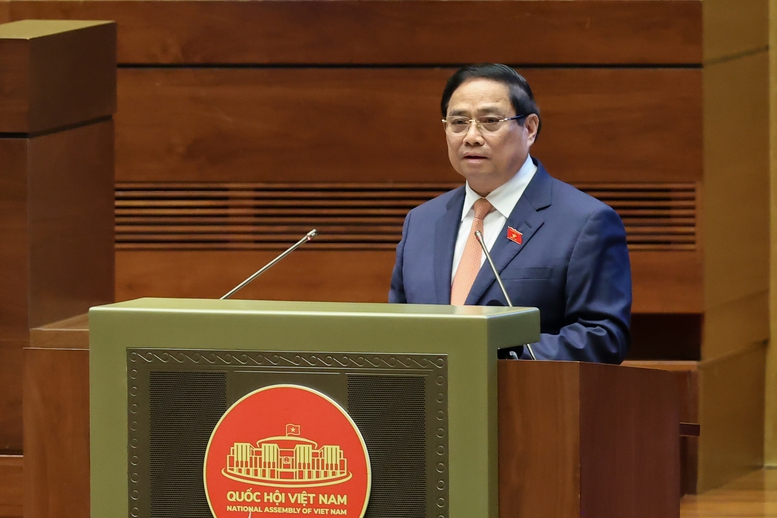
Prime Minister Pham Minh Chinh delivers a report at the 10th Session of the 15th National Assembly – Photo: VGP/Nhat Bac
On the morning of October 20th, at the opening session of the 10th National Assembly (15th term), Prime Minister Pham Minh Chinh presented a summary report on the implementation of the Socio-Economic Development Plan for 2025 and the 5-year period 2021-2025, along with the proposed socio-economic development plan for 2026.
The Prime Minister stated that during the 2021-2025 period, amidst a complex and unpredictable global context with many unforeseen challenges, particularly the severe aftermath of the COVID-19 pandemic, Vietnam faced more difficulties than opportunities domestically. However, with strong determination, significant efforts, and decisive actions, the country achieved and surpassed 22 out of 26 key socio-economic targets, nearly meeting 2 out of 26 targets. Notably, all social and welfare targets were exceeded, and in 2024 and 2025, all 15 socio-economic targets were met or surpassed.
The Government’s report highlights eight notable achievements.
First, Vietnam successfully controlled and effectively recovered from the COVID-19 pandemic, prioritizing “people’s health and lives above all,” earning international recognition and praise.
This involved shifting the approach to combine vaccination with administrative measures. Through diplomatic efforts and the rapid implementation of a nationwide free vaccination campaign, Vietnam transitioned from being behind to becoming a global leader, ranking 5th in vaccine coverage. The mortality rate in Vietnam was approximately 0.37%, significantly lower than the global average of 1%. Additionally, the country adapted flexibly and safely, reopening the economy while providing support to over 68.4 million workers and 1.4 million employers, totaling 119 trillion VND. Tax exemptions, reductions, and deferrals amounted to 580 trillion VND, and 23,300 tons of rice were distributed. The Socio-Economic Recovery and Development Program has been implemented with over 265 trillion VND disbursed.
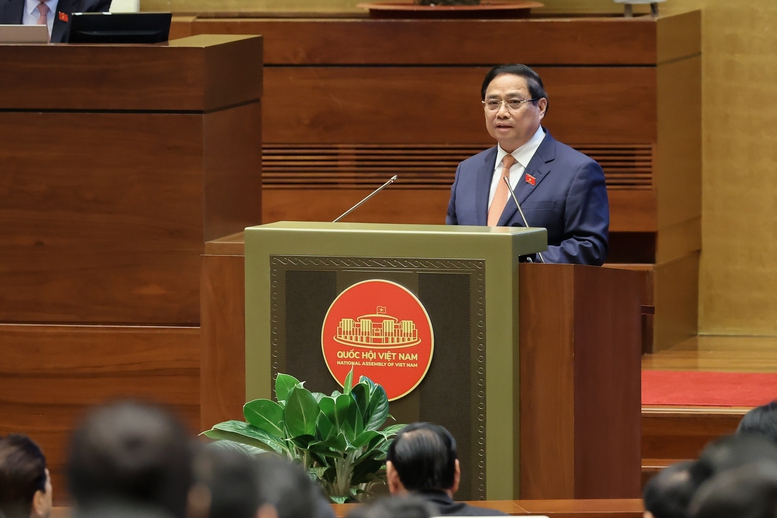
Prime Minister Pham Minh Chinh highlights eight notable achievements – Photo: VGP/Nhat Bac
Second, Vietnam’s economy demonstrated resilience against external shocks, maintaining one of the highest growth rates globally.
The GDP for 2025 is projected to increase by over 8%, with an average growth rate of 6.3% from 2021 to 2025, higher than the previous term (6.2%). Despite a 2.55% growth in 2021 due to the pandemic, the average growth rate from 2022 to 2025 was 7.2%, exceeding the target of 6.5-7%. The economy expanded from 346 billion USD in 2020 to 510 billion USD in 2025, rising five positions to 32nd globally. The per capita GDP in 2025 is estimated at around 5,000 USD, 1.4 times higher than in 2020, placing Vietnam in the upper-middle-income group. Economic structure and growth quality have improved positively.
Macroeconomic stability has been maintained, with inflation controlled below 4% and balanced economic indicators. State budget revenue is expected to reach 9.6 trillion VND, 1.36 times higher than the previous term, surpassing the target of 8.3 trillion VND. This was achieved while providing tax exemptions, reductions, and deferrals totaling 1.1 trillion VND and increasing revenue and saving 1.57 trillion VND in expenditures. The foreign exchange market remains stable, and the average lending interest rate decreased by 2.5% compared to 2022. Public debt reduced from 44.3% of GDP in 2020 to approximately 35-36% in 2025 (with a limit of 60% of GDP). The budget deficit averaged 3.1-3.2% of GDP, down from 3.53% in the 2016-2020 period. FTSE upgraded Vietnam’s stock market from Frontier to Secondary Emerging.
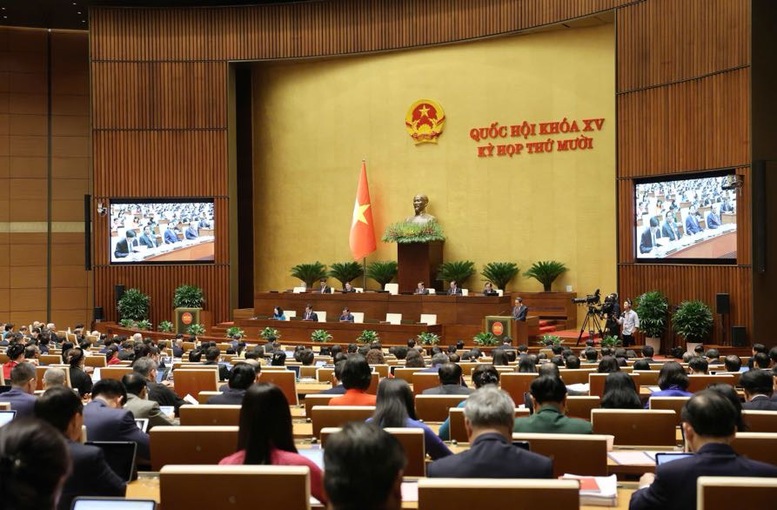
Opening session of the 10th National Assembly (15th term) – Photo: VGP/Nhat Bac
Traditional growth drivers have been effective, with total social investment reaching approximately 33.2% of GDP, meeting the 32-34% target. Public investment totaled around 3.4 trillion VND, a nearly 55% increase (1.2 trillion VND in absolute terms) compared to the previous term. Investment was focused, reducing the number of centrally funded projects from 11,000 to 4,600. FDI reached 185 billion USD, a nearly 9% increase, placing Vietnam among the top 15 developing countries in FDI attraction. Trade volume grew significantly from 545.4 billion USD in 2020 to approximately 900 billion USD in 2025, ranking Vietnam among the top 20 global economies. A substantial trade surplus of 88.3 billion USD was achieved, more than double the previous term. Tourism rebounded, with 22-23 million international visitors expected in 2025, the highest ever.
Third, the three strategic breakthroughs were implemented decisively and effectively, creating new development opportunities.
Legal development and enforcement were innovated in both thinking and implementation, addressing many bottlenecks. The Politburo issued several groundbreaking resolutions, and the National Assembly passed over 180 laws, ordinances, and resolutions, with 820 decrees issued, the most in any term. Nearly 4,300 business regulations and administrative procedures were simplified.
Infrastructure development saw significant breakthroughs with large-scale, modern, and interconnected projects. By the end of 2025, 3,245 km of expressways (exceeding the 3,000 km target) and 1,711 km of coastal roads (exceeding the 1,700 km target) are expected to be completed. The first phase of Long Thanh International Airport, meeting 4F standards, is nearing completion. Urban rail projects, seaports, and airports are operational. The 500 KV Quang Binh – Hung Yen and Lao Cai – Vinh Yen power lines were completed in record time. Social and cultural infrastructure received substantial investment, with the National Exhibition Center (VEC) ranking among the top 10 globally through public-private partnerships.
The labor structure improved, with the agricultural labor share decreasing from 28.3% in 2020 to 25% in 2025, and the trained labor share increasing from 64.5% to 70%. Plans include training 100,000 semiconductor and AI engineers by 2030. Labor productivity growth in 2025 is estimated at 6.85%, exceeding the 6.5% target.
Fourth, science, technology, innovation, and digital transformation were vigorously pursued, yielding significant initial results.
The National Innovation Center and National Data Center are operational and effective. Vietnam’s Global Innovation Index for 2025 ranked 44th out of 139 countries. Digital infrastructure expanded widely, with 100% of communes and wards having broadband fiber optic access, and mobile internet speeds among the top 20 globally. E-commerce grew rapidly, averaging 20% annually. Digital government, economy, and society initiatives made notable progress, with Project 06 saving approximately 3 trillion VND annually. The E-Government Development Index for 2024 ranked 71st out of 193, a 15-position increase from 2020. One million hectares of high-quality, low-emission rice were cultivated in the Mekong Delta.
Fifth, many long-standing projects were decisively addressed, releasing resources for development.
Five weak banks (four commercial banks and the Development Bank) were restructured and now operate stably and efficiently. Twelve loss-making projects and energy projects were resolved, including the Song Hau 1, Long Phu 1, Thai Binh 2, Van Phong 1, Nghi Son Refinery, and O Mon Power Plant. Nearly 1,200 projects worth 675 trillion VND were revived. Efforts are ongoing to review and address nearly 3,000 projects with capital in the trillions and land use in the hundreds of thousands of hectares.
Sixth, cultural and social sectors saw progress in awareness, action, and outcomes, improving people’s lives.
The cultural and entertainment industries are thriving, with 10 Vietnamese cultural heritages recognized by UNESCO. The Human Development Index (HDI) increased by 18 positions to 93rd out of 193 countries. Healthcare infrastructure expanded, with health insurance coverage rising from 90.2% in 2020 to 95.2% in 2025. Education quality improved, with many universities rising in international rankings. All 194 Vietnamese students participating in international Olympiads won awards. Tuition fees from preschool to high school were waived or subsidized starting in the 2025-2026 school year, and meal support was provided for students in disadvantaged areas. Construction of 248 modern boarding schools in border areas is underway, with 100 schools expected to be completed by the 2026-2027 school year.
Social welfare policies were comprehensively implemented, with 1.1 trillion VND spent on social welfare (17% of the state budget), supporting nearly 700,000 tons of rice for the needy. The multidimensional poverty rate decreased from 4.4% in 2021 to 1.3% in 2025. Average monthly income increased from 5.5 million VND in 2020 to 8.3 million VND in 2025. Over 334,000 substandard houses were eliminated, completing the target five years and four months ahead of schedule. Construction of 633,000 social housing units is ongoing, with 100,000 expected to be completed in 2025. The Vietnam Bank for Social Policies provided 517 trillion VND in loans to 10.6 million poor and near-poor households, including 22.1 trillion VND for social housing.
Disaster risk management, climate change adaptation, and environmental protection were prioritized, with 47 trillion VND allocated for disaster response. Vietnam’s Sustainable Development Index ranked 51st out of 165, a 37-position increase from 2016.
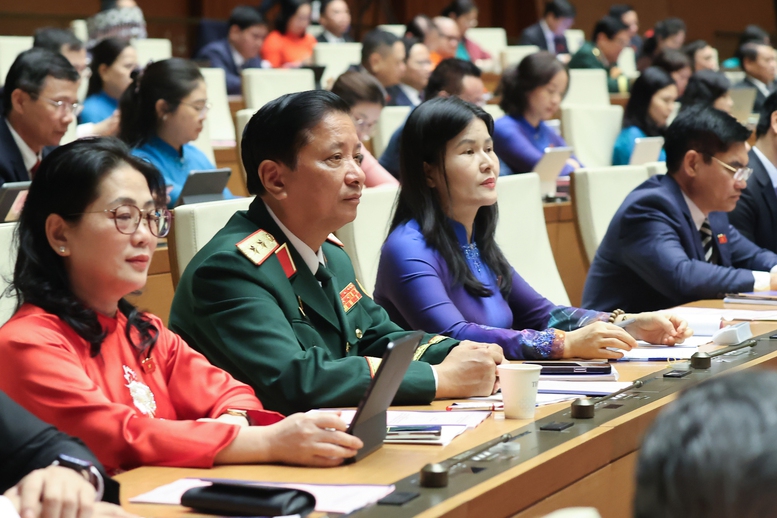
Delegates at the session – Photo: VGP/Nhat Bac
Seventh, government restructuring and local administration streamlining were effectively implemented, enhancing public service.
The administrative workforce was reduced by 145,000, saving 39 trillion VND annually. Local governments are transitioning from administrative management to serving the people and fostering development. Anti-corruption efforts intensified, recovering nearly 425 trillion VND and 2,200 hectares of land. Over 13.6 trillion VND and 520,000 USD were recovered from corruption cases, with assets worth nearly 438 trillion VND seized.
Eighth, national defense and security were strengthened, ensuring sovereignty and public order.
Resources were prioritized for defense and security, with some key weapons produced domestically. Crime prevention efforts were successful, and international peacekeeping missions were accomplished. Diplomatic and economic engagement enhanced Vietnam’s global standing, with strategic partnerships established with 38 countries, including all five permanent UN Security Council members and 17 G20 members. Vietnam was re-elected to the UN Human Rights Council for the 2026-2028 term.
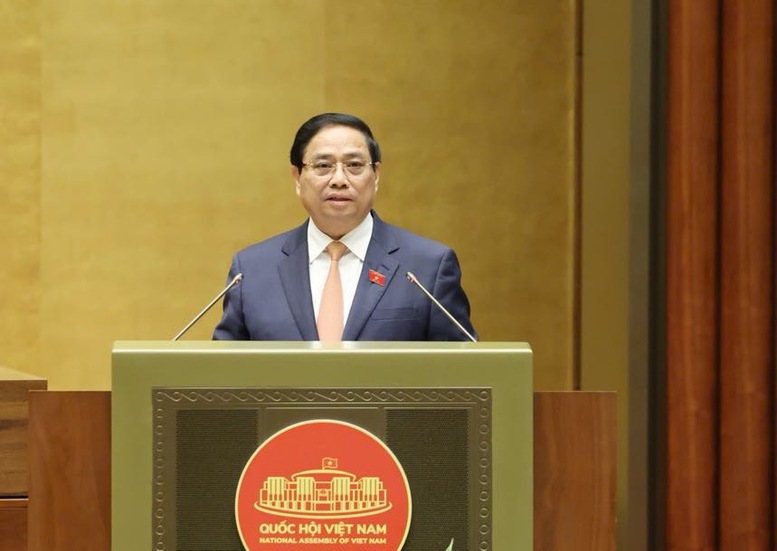
The Prime Minister emphasizes that tasks and solutions until year-end include effectively implementing resolutions to achieve over 8% growth while maintaining macroeconomic stability – Photo: VGP/Nhat Bac
The Prime Minister noted that despite significant achievements, challenges remain. Macroeconomic stability requires continued effort. Policies must better leverage human, natural, and cultural resources while protecting the environment. Real estate, gold, and bond markets remain volatile. Some sectors face production and business difficulties. Science, technology, and digital transformation have yet to become primary growth drivers. There is a shortage of high-quality human resources, especially in key sectors. Legal inconsistencies and administrative procedures need further streamlining. Government restructuring and local administration reforms face implementation challenges. Addressing long-standing projects and land issues requires more effort. Living standards in remote and ethnic minority areas need improvement. Environmental issues, urban congestion, and climate-related disasters persist. Security threats, including cybercrime, remain complex.
The Prime Minister attributed these achievements to the leadership of the Party Central Committee, the National Assembly’s supervision, and the Government’s decisive actions. Public support and international cooperation also played crucial roles.
Key tasks and solutions for the remainder of the year include implementing resolutions to achieve over 8% growth, maintaining macroeconomic stability, controlling inflation, and ensuring fiscal balance. Efforts will focus on resolving project bottlenecks, disbursing public investment, and launching major projects by December 19, 2025. Social welfare, disaster response, public order, and international integration will be prioritized.
Vietnam’s Economy Demonstrates Resilience Against External Shocks, Prime Minister Confirms Global Growth Leadership
At the opening session of the 10th Meeting of the 15th National Assembly, Prime Minister Pham Minh Chinh highlighted eight remarkable achievements in the implementation of the Socio-Economic Development Plan for 2025 and the five-year period 2021–2025. Notably, Vietnam’s economy has demonstrated robust resilience against external shocks, sustaining one of the highest growth rates globally. Additionally, Vietnam’s economic scale has surged by five ranks, now standing as the 32nd largest economy in the world.
Inauguration of the 10th Session, 15th National Assembly
This morning, October 20th, the 10th Session of the 15th National Assembly officially commenced with a solemn ceremony at the National Assembly House in Hanoi, the capital city. The session is scheduled to span 40 consecutive working days.


